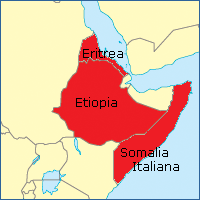| Northern front, East Africa, 1940 | |||||||
|---|---|---|---|---|---|---|---|
| Part of East African Campaign (World War II) | |||||||
 Italian East Africa (Africa Orientale Italiana) 1940 | |||||||
| |||||||
| Belligerents | |||||||
| Commanders and leaders | |||||||
| William Platt | Luigi Frusci | ||||||
| Units involved | |||||||
|
Sudan Defence Force Northern Rhodesia Regiment | Comando Forze Armate dell'Africa Orientale Italiana | ||||||
Operations on the Northern front, East Africa, 1940 in the Second World War, were conducted by the British in Sudan and the Armed Forces Command of Italian East Africa (Comando Forze Armate dell'Africa Orientale Italiana) in Eritrea and Ethiopia. On 1 June 1940, Amedeo, Duke of Aosta the Viceroy and Governor-General of the Africa Orientale Italiana (AOI, Italian East Africa), commander in chief of the Armed Forces Command of the Royal Italian Army (Regio Esercito) and General of the Air Force (Generale d'Armata Aerea), had about 290,476 local and metropolitan troops (including naval and air force personnel) and by 1 August, mobilisation had increased the number to 371,053 troops. General Archibald Wavell, General Officer Commanding-in-Chief (GOC-in-C) of Middle East Command, had about 86,000 troops at his disposal for Libya, Iraq, Syria, Iran and East Africa. About 36,000 troops were in Egypt and 27,500 men were training in Palestine.
Hostilities began soon after the Italian declaration of war on 10 June 1940. On the Sudan–Eritrea and Sudan–Ethiopia borders, the Italian army captured Kassala, on 4 July, then Gallabat; Karora was occupied unopposed and Kurmuk taken on 7 July. The possibility of an Italian advance on Khartoum led the British to adopt a delaying strategy but apart from some local advances, the Italians fortified Kassala and Gallabat and made no offensive move. In August the Italians invaded British Somaliland and the British made a slow retreat to the coast then embarked for Aden, at some cost to the reputation of Wavell with the Prime Minister Winston Churchill. The British reversed their recognition of the Italian conquest of Ethiopia in the Second Italo-Ethiopian War (1935–1936) in favour of Haile Selassie, the deposed emperor. Mission 101 and Gideon Force were based in Sudan to conduct sabotage and subversion in the western Ethiopian province of Gojjam. After an abortive counter-attack at Gallabat in November, the British conducted patrols and raids against the Italians with Gazelle Force in the Mareb River/Gash River delta north of Kassala and bluffed their opponents into believing that the British had much larger forces in eastern Sudan.
The British blockade of the AOI made Aosta reluctant to deplete stocks of fuel, ammunition and spare parts after the invasion of British Somaliland was complete. With expectations that the Germans would defeat Britain before the end of 1940 and with the need to wait for the Italian invasion of Egypt (9–16 September 1940) to succeed before invading Sudan, the Italians in the AOI waited on events. British policy was to ensure the safety of shipping in the Red Sea and the Gulf of Aden and operations in East Africa were given second priority after Egypt. With reinforcements arriving from India and troops from Egypt due after Operation Compass, the British planned to invade Eritrea from Sudan on 9 February 1941. The British were forestalled by a sudden Italian retreat from Kassala on 18 January and Platt was ordered to mount a vigorous pursuit. The British invaded Eritrea and defeated the Italians at the Battle of Agordat (26–31 January 1941) which began the conquest of Eritrea; Selassie returned to Ethiopia on 20 January.